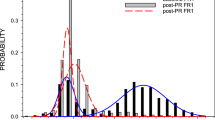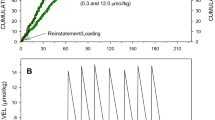Abstract
The effects of haloperidol 0.1 mg/kg on the partial reinforcement extinction effect (PREE) paradigm at one trial a day, were examined. Two groups of rats were trained to run in a straight alley. The continuously reinforced (CRF) group received food reward on every trial. The partially reinforced (PRF) group was rewarded on a quasirandom 50% schedule. All animals were then tested in extinction. Haloperidol 0.1 mg/kg was administered in a 2 × 2 design, i.e., drug-no drug in acquisition and drug-no drug in extinction. The PREE, i.e., increased resistance to extinction of partially reinforced as compared to continuously reinforced animals, was obtained in all four drug conditions. The administration of haloperidol in acquisition increased markedly resistance to extinction in CRF animals. The administration of the drug in extinction decreased resistance to extinction in both CRF and PRF animals. The results are explained in terms of two independent actions of haloperidol: the well-known effect of reduction in the effectiveness of reinforcement as well as enhancement of the effectiveness of nonreinforcement.
Similar content being viewed by others
References
Anisman H, Zacharko RM (1982) Stimulus change influences escape performance: deficits induced by unctrollable stress and by haloperidol. Pharmacol Biochem Behav 17:263–269
Anisman H, Remington G, Sklar LS (1979) Effects of inescapable shock on subsequent escape performance: catecholaminergic and cholinergic mediation of response initiation and maintenance. Psychopharmacology 61:107–124
Beninger RJ, Freedman NL (1982) The use of two operants to examine the nature of pimozide-induced decrease in responding for brain stimulation. Physiol Psychol 10:409–412
Beninger RJ, MacLennan AJ, Pinnel JPJ (1980a) The use of conditioned defensive burying to test the effects of pimozide on associative learning. Pharmacol Biochem Behav 12:445–448
Beninger RJ, Mason ST, Phillips AG, Fibiger HC (1980b) The use of extinction to investigate the nature of neuroleptic-induced avoidance deficits. Psychopharmacology 69:11–18
Beninger RS, Cheng M, Hahn BL, Hoffman DC, Mazurski EJ, Morency MA, Ramm P, Stewart RJ (1987) Effects of extinction, pimozide, SCH 23390 and metoclopramide on food-rewarded operant responding of rats. Psychopharmacology 92:343–349
Corradini A, Tombaugh TN, Anisman H (1984) Effects of pimozide on escape and discrimination performance in a water-escape task. Behav Neurosci 98:96–106
Ettenberg A, Camp CH (1986a) Haloperidol induces a partial reinforcement extinction effect in rats: implications for a dopamine involvement in food reward. Pharmacol Biochem Behav 25:813–821
Ettenberg A, Camp CH (1986b) A partial reinforcement extinction effect in water — reinforced rats intermittently treated with haloperidol. Pharmacol Biochem Behav 25:1231–1235
Ettenberg A, Koob GF, Bloom FE (1981) Response artifact in the measurement of neuroleptic-induced anhedonia. Science 213:357–359
Feldon J, Gray JA (1981) The partial reinforcement extinction effect after treatment with chlordiazepoxide. Psychopharmacology 73:269–275
Fibiger HC (1978) Drugs and reinforcement: a critical review of the catecholamine theory. Annu Rev Pharmacol Toxicol 18:37–56
Fibiger HC, Zis AP, Phillips AG (1975) Haloperidol induced disruption of conditioned avoidance responding: attenuation by prior training or by anti-cholinergic drugs. Eur J Pharmacol 30:309–314
Franklin KBJ, McCoy SN (1979) Pimozide-induced extinction in rats: Stimulus control of responding rules out motor deficit. Pharmacol Biochem Behav 11:71–75
Gray JA (1975) Elements of a two-process theory of learning. Academic Press, London
Halevy G, Feldon J, Weiner I (1986) The effects of clonidine on the partial reinforcement extinction effect (PREE). Psychopharmacology 90:95–100
Liebman JM (1982) Discriminating between reward and performance: a critical review of intracranial self-stimulation methodology. Neurosci Biobehav Rev 7:45–72
Mackintosh NJ (1974) The psychology of animal learning. Academic Press, New York
Mason ST, Beninger RJ, Fibiger HC, Phillips AG (1980) Pimozide-induced suppression of responding: evidence against a block of food reward. Pharmacol Biochem Behav 12:917–923
Phillips AG, Fibiger HC (1979) Decreased resistance to extinction after haloperidol: implications for the role of dopamine in reinforcement. Pharmacol Biochem Behav 10:751–760
Phillips AG, McDonald AC, Wilkie DM (1981) Disruption of autoshaped responding to a signal of brain-stimulation reward by neuroleptic drugs. Pharmacol Biochem Behav 14:543–548
Spyraki C, Fibiger HC, Phillips AG (1982) Attenuation of place preference conditioning using food reinforcement. Psychopharmacology 77:379–382
Tombaugh TN, Tombaugh J, Anisman H (1979) Effects of dopamine receptor blockade on alimentary behaviors: home cage food consumption, magazine training, operant acquisition, and performance. Psychopharmacology 66:219–225
Tombaugh TN, Anisman H, Tombaugh J (1980) Extinction and dopamine receptor blockade after intermittent reinforcement training: failure to observe functional equivalence. Psychopharmacology 70:19–28
Weiner I, Bercovitz H, Lubow RE, Feldon J (1985) The abolition of the partial reinforcement extinction effect (PREE) by amphetamine. Psychopharmacology 86:318–323
Weiner I, Feldon J, Bercovitz H (1987) The abolition of the partial reinforcement extinction effect (PREE) by amphetamine: disruption of control by nonreinforcement. Pharmacol Biochem Behav 27:205–210
Wise RA (1982) Neuroleptics and operant behavior. Behav Brain Sci 5:39–87
Wise RA, Colle LM (1984) Pimozide attenautes free feeding: best scores analysis reveals a motivational deficit. Psychopharmacology 84:446–451
Wise RA, Spindler H, deWitt H, Gerber GJ (1978) Neuroleptic-induced “anhedonia” in rats; pimozide blocks the reward quality of food. Science 201:262–264
Author information
Authors and Affiliations
Rights and permissions
About this article
Cite this article
Feldon, J., Katz, Y. & Weiner, I. The effects of haloperidol on the partial reinforcement extinction effect (PREE): implications for neuroleptic drug action on reinforcement and nonreinforcement. Psychopharmacology 95, 528–533 (1988). https://doi.org/10.1007/BF00172968
Received:
Revised:
Issue Date:
DOI: https://doi.org/10.1007/BF00172968




